By Russell A. Carter, Managing Editor
New shaft inspection services and technology offer the prospect of quicker—but more effective—underground checks, with less risk to personnel
A common notion in underground mining is that each mine is unique, because each deposit has its own set of geologic, geochemical and geophysical characteristics. A logical extension of this view is that each mine shaft also is unique; although modern shafts are built in accordance with accepted engineering principles and applicable standards and regulations, they are, ultimately, designed to meet the needs of the site and the operation.
 Siemag Tecberg’s mobile shaft winch can be used to conduct routine shaft inspections as well as to carry out worker rescue operations, according to the company.
Siemag Tecberg’s mobile shaft winch can be used to conduct routine shaft inspections as well as to carry out worker rescue operations, according to the company.
The flip side of the coin is that, despite their relative uniqueness, active mine shafts are bound by a common denominator—they all must be regularly inspected. The combined forces of gravity, corrosion and age wage an ongoing battle with shaft components and efficiency, and an unplanned shutdown of any major shaft can have a disastrous economic impact on the operation. For example, in early 2012, Hecla Mining Co. was ordered by the U.S. Mine Safety and Health Administration to close the Silver shaft at its Lucky Friday mine in Mullan, Idaho, for removal of dirt and concrete material that had accumulated in the shaft over the course of years. The Silver shaft is a one-mile deep shaft from the surface and the primary access to the Lucky Friday mine. The mine had to be put on care and maintenance status for a year, while Hecla spent almost $30 million on shaft rehabilitation and lost an estimated $135 million from unrealized silver, lead and zinc revenues during the shutdown.
Shaft inspection is generally regarded as a necessary, but costly, responsibility—and a job that can be dangerous at times. In August 2010, two miners died at Barrick Gold’s Meikle mine in Nevada, USA, during a shaft inspection when a section of 2-ft-diameter pipe broke off and struck their man cage. Earlier this year, a worker died and two others were injured at another U.S. mine, the Cote Blanche underground salt mine in Louisiana, owned and operated by North American Salt Co. The three were replacing a bushing on the side of a skip hoist in the production shaft when a large chunk of salt fell and struck them.
Mature mine shafts are subject to the cumulative effects of time, wear and corrosion, and as mine operators extend production into deeper areas, shafts lengthen accordingly, thus taking longer to inspect and adding to the inherent risks and overall expense. However, on the plus side, vendors are also advancing shaft-related product portfolios, electronic technology, and monitoring capabilities to alleviate some of the costs and danger associated with these inspections. Here a few examples.
Going Mobile
In mid-2012, Siemag Tecberg unveiled its latest mobile shaft winch during a customer event at its headquarters in Haiger, Germany. The winch, specifically designed and manufactured for the Xinwen Coal Group operation in China’s Shandong province, is intended to function as an autonomous hoisting system for the inspection of mine shafts as well as for emergency rescue of personnel.
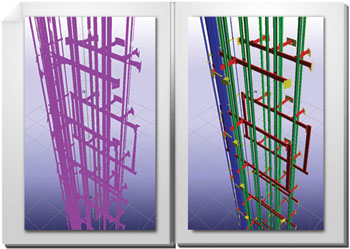 MS3 is capable of acquiring billions of data points to produce a realistic 3-D image of an entire shaft with all internal infrastructures.
MS3 is capable of acquiring billions of data points to produce a realistic 3-D image of an entire shaft with all internal infrastructures.
The winch itself is mounted on a modified four-axle Man truck, equipped with a six-cylinder, four-stroke diesel engine, rated at 360 hp (265 kW) at 1,600–1,900 rpm. The operator’s cabin, a telescopic jib, drum winch and drive components necessary for the jib and winch movements are located on a rotating platform that is connected to a base frame by a double-row, ball-bearing-mounted slewing rim.
The winch, according to the company, is usually operated in combination with the deflection sheave located at the jib end, or alternatively by using an external rope sheave located in the head frame. The winch is equipped with two rescue cages, approved for the transport of up to four and 10 persons on two decks, respectively.
Depending on specific site conditions, the jib assembly and the winch itself can be operated by an electrical pump unit, or independent of external power by a diesel-driven pump unit. The two drive systems ensure operational redundancy.
The hoisting rope on the winch drum is about 1,300-m long, with a 24-mm diameter. A shielded cable is embedded within the wire rope center to enable hard-wired communication and transmission of safety signals between the workers in the rescue cage and the winch operator.
The system is interfaced through a touch panel at the operator’s console inside the control cabin. The company noted that, when starting the winch, the load pickup at any depth is sensed by redundantly arranged pressure switches and the winch control software; formerly this was accomplished by a pressure-value accumulator. This new concept, said Siemag Tecberg, ensures that the winch is started softly regardless of the actual payload in the hoisting cage.
The company also pointed out several notable improvements related to the diesel unit involved in winch operation, including 15% better performance and longer battery life. The latest unit also allows resetting of the depth indicator to zero, independently of the current position of the rescue cage.
Streamlining the Process
A mine inspection system based on LiDAR (Light Detection and Ranging) technology and high-resolution photography has been developed by Canada’s Sight Power Inc. The Mobile Shaft Scanning System (MS3) combines three core elements—lasers, Global Positioning System (GPS) and Inertial Navigation System (INS)—to offer the prospect of substantial savings and safety improvements by ultimately allowing inspection without stopping production.
“LiDAR systems are ideal for mine shaft inspection, because the typical distance from the scanning device to objects within the shaft barrel is only 3–4 m,” said Sight Power CEO and CTO Borys Vorobyov. “But without GPS, a variety of positional aids are required to assist the INS, including inertial sensors such as accelerometers and inclinometers.”
Sight Power got help from Sherborne Sensors, a New Jersey, USA-based company that designs, develops and manufactures sensors for military, aerospace and industrial applications. Its DSIC inclinometers and A323 accelerometers are used in the MS3 system to provide accurate geo-reference position data.
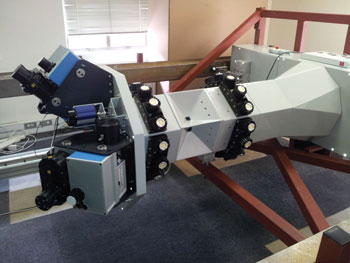
Sight Power’s MS3 mine inspection system is designed to be attached to the shaft conveyance. Its autonomous operation should lead to quicker, safer inspections, says the Canada-based system developer.
The conventional mineshaft inspection procedure is to lower workers down the shaft in an elevator at a speed below 1 m/sec. However, with the MS3 system, the laser scanning device is attached to the cage assembly and will move up and down the shaft at speeds that enable quick and unobtrusive shaft scanning. Because GPS is not available underground, the system’s high-precision inclinometers measure the amount of roll and pitch of the carriers to give an indication of whether or not the movement down the shaft is well controlled. Meanwhile, the accelerometers measure the performance of the carriers with respect to vibration and acceleration during normal operation as well as during inspection cycles.
“Our gravity-referenced servo inclinometers and accelerometers are very robust, extremely accurate and field-proven,” said Sherborne Sensors’ Jesse Bonfeld, vice president of business development. “Their dynamic range means that their output is more conducive to the volume of data required and integrates seamlessly into the MS3 data acquisition system. The fact that these inertial sensors are temperature compensated was also a key factor in ensuring accuracy of results, because the temperature varies dramatically as you travel along the length of a mine shaft.”
Ultimately, the system’s objective is to provide quick and unobtrusive shaft scanning, with the device attached to the conveyance and moving up and down the shaft with an average speed significantly higher than that possible during manual visual inspections. According to Sight Power, MS3 is capable of acquiring billions of data points to produce a realistic 3-D image of an entire shaft with all internal infrastructures. The resulting Digital Spatial 3-D model can then be imported into a software package such as AutoCAD, or use Sight Power’s software to analyze any horizontal or vertical cross-section, measure sizes, distances, diameters and angles and compare them to the original construction measurements.
The initial 3-D model of a mineshaft will provide an accurate view of current shaft conditions, with subsequent scans then compared against it to identify changes within the shaft and to identify any elements of the shaft infrastructure that have been affected. The change detection algorithms are included in Sight Power’s software.
Because each mine shaft is unique, it was important for MS3’s designers to provide a way to configure the generic MS3 system for a particular mine shaft’s conditions. In order to make this process well-defined and consistent, a special mine shaft scanning simulation tool has been developed. Using the initial mine shaft model and setting up certain parameters (number of scanners, their speed and angle of scanning, orientation, etc.), the tool assists the designer in finding the optimal solution and the most appropriate MS3 configuration for the particular mine shaft. The tool can be used to define the number of required scanners, their orientation, position and parameters prior to the assembly of the real system. The goal, according to the company, is to provide the best possible quality of scans (no blind spots or at least a minimum of known blind spots, sufficient density of points vs. scanning speed, etc.).
MS3 will also take digital photos by means of a stroboscopic, high-resolution digital photographic module and then combine them with the LiDAR data to create more realistic 3-D images. When analyzing these 3-D images, engineers will be able to focus on areas of concern such as ground movements, cracks in lining, misalignment and deflections of pipes, buntons, and guides.
Sight Power contends that, assuming the MS3 approach is accepted by the mining industry and regulatory authorities, it has the potential to reduce production stoppage times by at least 50% annually. It would also mean less man hours spent underground in hostile environments. By halving the number of visual inspections, MS3 would enable more available hoisting time and consequently significantly increase the mine’s revenue and profitability. Perhaps more importantly, engineers will be able to detect defects at a much earlier stage, cutting shaft maintenance repair costs and downtime, and enabling engineers to address any issues before they become a major safety hazard and operational issue.
Putting on the Top Hat
Approaching shaft inspection from an entirely different angle, Tata Steel recently announced plans to offer new, larger mine shaft guides. Its “top hat” guide, a product produced exclusively by Tata Steel, is claimed to offer a number of benefits to mine owners and designers, from simpler manufacture to reduced maintenance and easier replacement. From the shaft-inspection point of view, they offer the prospect of allowing faster, more thorough inspections because their design provides visibility from all sides.
Tata Steel’s sales and marketing director for lifting and excavating, Gareth Beese, said, “As an organization we are committed to listening to what the industry wants and needs, globally, and working with them to deliver it. The industry has asked for larger mineshaft guides, and that’s exactly what we’re developing.”
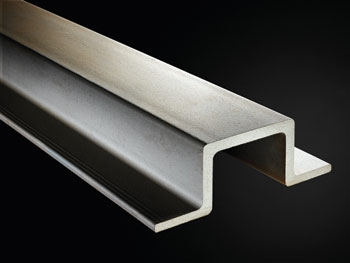 Tata Steel is investigating the benefits of offering a new, larger-gauge top hat shaft guide.
Tata Steel is investigating the benefits of offering a new, larger-gauge top hat shaft guide.
The company’s Special Profiles mill at Skinningrove, U.K., is in the process of researching and testing a 175-mm-gauge top hat. According to the company, its top hat has a thicker metal gauge than alternative products—between 13.5 mm and 18 mm—offering increased corrosion allowance, strength and vibration resistance. The stiffer, stronger, straighter nature of the finished product allows heavier loads to be conveyed faster, leading to increased productivity. The open design of the guides make it easier to inspect and maintain, which when coupled with improved corrosion resistance makes a product that matches the lifetime of a mine, typically 20 to 30 years, according to the company.
In a paper presented at the 23rd World Mining Congress in Montreal, Canada, earlier this year, Colin Mawdsley, customer technical service engineer at Tata Steel, explained that modern shaft designs, particularly those originating in South African operations, generally result in a shaft that incorporates a 340 x 100 x 10 rectangular hollow section (RHS) buntons with 6-m in-shaft spacing. Guides are of two fundamental types: either the 150 x 10 x 10-mm square hollow section (SHS) or the 150-mm top hat section. In corrosive shaft environments, Mawdsley said, the 10-mm thickness of the SHS guide has little, if any, allowance for corrosion loss. Conversely, the 150-mm-deep top hat is from 13.5-mm to 18-mm thick, which helps to optimize the structural performance. The heavier gauge generally allows a higher acceptable corrosion loss without causing undue structural concern.
Even with this extra protection, detection of corrosion during service remains a key inspection requirement, he cautioned. With the top hat guide, all sides are visible for both visual inspection and any necessary repair. On the presumption that the grease coating on the front of the guides will provide some corrosion protection, the focus for routine inspections can be from the back face. This would reduce the time needed for the inspection of individual guides and this may facilitate the opportunity to ensure high-quality inspection right to the bottom of the shaft. If it becomes necessary to replace guides, either due to excessive corrosion or possible mechanical deformation, the standard butt-strap connection used with top hat guides makes replacement the least difficult option.
Mawdsley said that fabrication and installation of top hats is straightforward and the product’s close dimensional and straightness tolerances assist with these procedures. Inspection of in situ top hat guides is both faster and more precise as all surfaces can be seen, thus avoiding surprises from the type of inside-out corrosion that can be an issue with SHS. Top hat guides also offer the possibility of improved hoisting potential—as higher winding speeds and/or payload can be used due to better steelwork stiffness and rebound velocity ratios.
Hoisting Safety Improvements
Hoist safety and efficiency are so tightly linked to shaft conditions that if an abnormal hoist-related issue arises in a shaft between inspections, a mine must have a reliable means to detect a problem—preferably, by monitoring and controlling hoist performance and safety. ABB has introduced several new products and services in this area, the latest being a “safety” PLC for critical applications, and a new hoist performance monitoring service.
The AC500S safety PLC features a dual processor architecture that complies with SIL3/PL e functional safety levels. ABB said that, prior to commercial release, the new controller was extensively field tested over three years in some 10 pilot applications including different types of cranes, mining hoists, automatic guided vehicles and robotics.
The new safety PLC hardware shares the same look and feel as ABB’s standard AC500 PLC family for non-safety applications, as well as identical dimensions to standard ABB CPU and I/O modules, and the same mounting and wiring scheme. Both types of modules may be mixed in the same PLC, allowing it to perform both safety and non-safety functions. This can reduce the complexity and cost of many projects, and open up new options for applications such as data exchange between safety and non-safety elements of the control system.
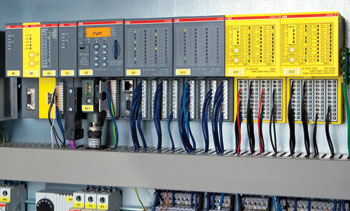 ABB’s new safety PLC hardware shares the same look and feel as its standard AC500 PLC family for non-safety applications, as well as identical dimensions to standard ABB CPU and I/O modules, and the same mounting and wiring scheme.
ABB’s new safety PLC hardware shares the same look and feel as its standard AC500 PLC family for non-safety applications, as well as identical dimensions to standard ABB CPU and I/O modules, and the same mounting and wiring scheme.
To support the development of safety-related applications, ABB has developed its own safety code analyzer (SCA) tool to verify safety programming rules or guidelines. The analyzer tool, according to the company, can help in the development of PLC code that is more reliable, better structured, and more easily readable, all of which contribute to lower certification effort and post-release maintenance costs.
ABB’s AC500-S PLC has a separate safety processor that can be configured to work even if the non-safety processor is in stop or maintenance mode, or during an online change. The dual processor architecture means that users can easily upgrade the performance of a safety PLC during its lifecycle by plugging in a faster non-safety CPU module. An important option is the availability of safety PLC modules in ABB’s XC “extreme conditions” variants. This option allows users to configure functional safety PLC solutions that are also ruggedized and suitable for operating in harsh conditions and extreme climates.
ABB’s recently announced Hoist Performance Monitoring Service connects a customers’ hoist system to ABB for monitoring and analysis of the hoist’s condition and performance. The new service combines hardware monitoring with secure remote access options and expert software. It offers two solutions to maintain hoist performance:
• Hoist service experts provide a scheduled quarterly analysis of collected data against established key performance indicators (KPIs). By utilizing remote sessions with ABB engineers corrective actions can be implemented. After every analysis, the customer gets an associated report.
• ABB offers continuous asset monitoring over extended periods of time. If the monitored hoist system shows abnormal conditions, pre-established triggers alert the customer immediately. ABB proactively investigates the source of the alarm and provides recommendations to restore process performance.
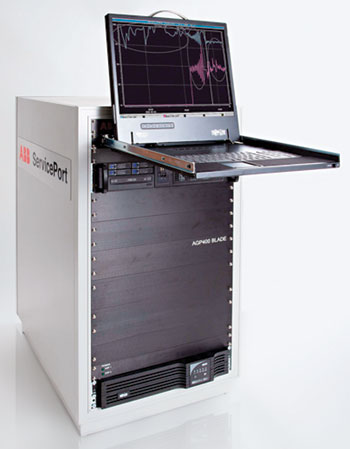 ABB’s ServicePort service delivery platform can be ordered with an optional integrated workstation, shown here.
ABB’s ServicePort service delivery platform can be ordered with an optional integrated workstation, shown here.
Powered by ServicePort, ABB’s service delivery platform, the Hoist Performance Monitoring Service uses continuous data collection and analysis to transform raw data into actionable information, pinpointing issues so that the hoist operator can ensure optimal performance of equipment and systems.
ServicePort enables the retrieval of information from numerous operational points, including the hoist’s motor, hydraulics and brakes, and helps to diagnose and identify root cause problems. As explained by ABB, ServicePort runs multiple channels that enable delivery of performance services, providing a way to visualize equipment and/or process performance. Through periodic or continuous analysis of KPIs, issues can be identified, classified and prioritized based on severity, process area, criticality and/or financial impact.
Performance service channels fall under three main categories:
• Equipment performance services monitor utilization and per formance of ABB-manufactured products, such as control systems, motors, drives, instruments and analyzers.
• Process performance services diagnose and improve production processes.
• Industry performance services diagnose and improve equipment or processes specific to a certain industry.
Each service channel offers a package of software tools that gathers, stores and analyzes system or process data within ServicePort. ABB claims that collected data is highly secure, as it remains on-site and requires user authentication to view. ABB’s Remote Access Platform (RAP) is used to provide custom firewalls and provides a detailed audit trail of anyone connecting to ServicePort by logging each remote session.
ABB said the new service “sets new standards in maintaining hoist systems” and its state-of-the-art remote access qualifies this new service product as unique in the underground mining market. It allows site engineers to continuously collaborate with ABB experts whenever support is needed.









